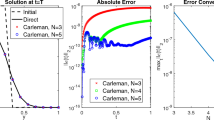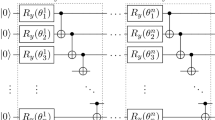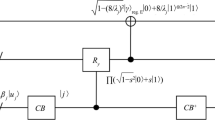Abstract
We study how to solve quantum stochastic differential equations (QSDEs) using a quantum computer. This is illustrated by an implementation of the QSDE that models the interaction of a laser driven two-level atom with the electromagnetic field in the vacuum state, on the IBMqx4 Tenerife quantum computer (IBM in The IBM Q experience. https://quantumexperience.ng.bluemix.net/qx. Accessed 23 Nov 2018, 2018). We compare the resulting master equation and quantum filtering equations to existing theory. In this way we characterize the performance of the computer.







Similar content being viewed by others
References
Aleksandrowicz, G., Alexander, T., Barkoutsos, P., Bello, L., Ben-Haim, Y., Bucher, D., et al.: Qiskit: An Open-source Framework for Quantum Computing. (2019). https://doi.org/10.5281/zenodo.2562110
Attal, S., Pautrat, Y.: From repeated to continuous quantum interactions. Ann. Henri Poincaré 7, 59–104 (2006)
Belavkin, V.P.: Quantum stochastic calculus and quantum nonlinear filtering. J. Multivar. Anal. 42, 171–201 (1992)
Bouten, L., van Handel, R., James, M.: An introduction to quantum filtering. SIAM J. Control Optim. 46, 2199–2241 (2007)
Bouten, L.M., van Handel, R.: Discrete approximation of quantum stochastic models. J. Math. Phys. 49, 102109 (2008)
Bouten, L.M., van Handel, R., James, M.: A discrete invitation to quantum filtering and feedback control. SIAM Rev. 51, 239–316 (2009)
Brun, T.A.: A simple model of quantum trajectories. Am. J. Phys. 70, 719–737 (2002)
Carmichael, H.J.: An Open Systems Approach to Quantum Optics. Springer, Berlin (1993)
Cross, A.W., Bishop, L.S., Smolin, J.A., Gambetta J.M.: Open quantum assembly language. ArXiv e-prints arXiv:1707.03429, July (2017)
Davies, E.B.: Quantum stochastic processes. Commun. Math. Phys. 15, 277–304 (1969)
Gough, J., James, M.: Quantum feedback networks: Hamiltonian formulation. Commun. Math. Phys. 287, 1109–1132 (2009)
Gough, J., James, M.: The series product and its application to quantum feedforward and feedback networks. IEEE Trans. Autom. Control 54, 2530–2544 (2009)
Gough, J., Sobolev, A.: Stochastic Schrödinger equations as limit of discrete filtering. Open Syst. Inf. Dyn. 11, 235–255 (2004)
Gross, J.A., Caves, C.M., Milburn, G.J., Combes, J.: Qubit models of weak continuous measurements: Markovian conditional and open-system dynamics. Quantum Sci. Technol. 3(2), 024005 (2018)
Hudson, R.L., Parthasarathy, K.R.: Quantum Itô’s formula and stochastic evolutions. Commun. Math. Phys. 93, 301–323 (1984)
IBM.: The IBM Q experience. https://quantumexperience.ng.bluemix.net/qx. Accessed 23 Nov 2018 (2018)
Kümmerer, B.: Markov dilations on \(W^*\)-algebras. J. Funct. Anal. 63, 139–177 (1985)
Lindsay, J.M., Parthasarathy, K.R.: The passage from random walk to diffusion in quantum probability II. Sankhya Indian J. Stat. 50, 151–170 (1988)
Maassen, H.: Quantum Markov processes on Fock space described by integral kernels. In: Accardi, L., von Waldenfels, W. (eds.) QP and Applications II, vol. 1136, pp. 361–374. Springer, Berlin (1985). Lecture Notes in Mathematics
Meyer, P.-A.: Quantum Probability for Probabilists. Springer, Berlin (1993)
Nielsen, M., Chuang, I.: Quantum Computation and Quantum Information. Cambridge University Press, Cambridge (2000)
Parthasarathy, K.R.: The passage from random walk to diffusion in quantum probability. J. Appl. Probab. 25A, 151–166 (1988)
von Waldenfels, W.: A Measure Theoretical Approach to Quantum Stochastic Processes, vol. 878. Springer, Berlin (2014). Lecture notes in Physics
Yip, K.W., Albash, T., Lidar, D.: Quantum trajectories for time-dependent adiabatic master equations. Phys. Rev. A 97, 022116 (2018)
Author information
Authors and Affiliations
Corresponding author
Additional information
Publisher's Note
Springer Nature remains neutral with regard to jurisdictional claims in published maps and institutional affiliations.
Rights and permissions
About this article
Cite this article
Vissers, G., Bouten, L. Implementing quantum stochastic differential equations on a quantum computer. Quantum Inf Process 18, 152 (2019). https://doi.org/10.1007/s11128-019-2272-z
Received:
Accepted:
Published:
DOI: https://doi.org/10.1007/s11128-019-2272-z




